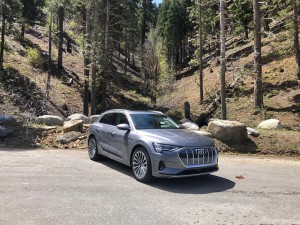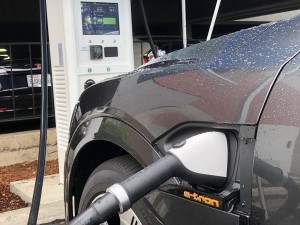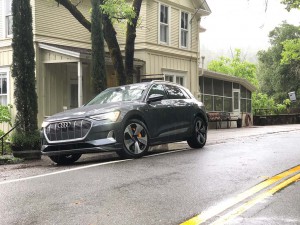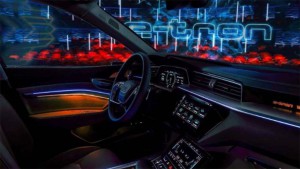
Audi's first electric vehicle, the 2019 e-tron, is almost indistinguishable from a regular sport-utility.
It may be the middle of May but it feels a lot more like the dead of winter as we race up the narrow, winding road to California’s Lake Tahoe ski resort. As we approach the 7,000-foot mark the winds swirl the freshly falling snow across the landscape.
Considering we’ve already traveled almost 80 miles, this would be a recipe for trouble were we driving a first-generation battery-electric vehicle. But that, the harsh weather, as well as the steep climb to Lake Tahoe, don’t begin to phase the new 2019 Audi e-tron we’re driving for the first time.
While Audi has toyed with a variety of clean-car technologies, including natural gas, hybrids and plug-ins, during the past decade, the e-tron is its first pure battery-electric vehicle – though it won’t be the last, the automaker confirming a total of four models, including the e-tron Sportback and striking e-tron GT that was one of the stars of the 2018 Los Angeles International Auto Show.
Its been nearly a decade since the first of what we might call the Gen-One electric vehicles came to market. The Nissan Leaf, was an example of the oft-radical approach to styling that marked some of the early offerings. That carried over into the longer-range, second generation such as the Tesla Model X, with its Falcon Wing doors, or the distinctively styled Jaguar I-Pace, its cab-forward design meant to yield a surprisingly roomy cabin despite a compact exterior footprint.

The new e-tron has no problem scaling mountains and dealing with cooler temps with its 200-plus mile range.
(Audi tweaks subscription service pricing plan. Click Here for the story.)
For its first all-electric model, however, Audi clearly wants to reach a mainstream audience, packing its new, all-electric drivetrain beneath a relatively conventional SUV body. In fact, measuring 193 inches nose-to-tail, 76.3 inches in width and 65.5 inches in height – with a wheelbase of 115.1 inches, you might be excused if, at first glance, you confuse it for a similarly sized Audi Q8 crossover.
The basic silhouette is similar, and there’s the classic, Audi grille – though a closer look there reveals the first clue that this isn’t a normal member of the Audi Q family. Again, hoping to look relatively mainstream, the German automaker opted to retain the singleframe design, rather than eliminating a grille entirely, as Tesla and others have opted for. But all but a narrow gap in the e-tron nose has been closed off to improve aerodynamics. Battery drive systems don’t need to feed air into their engines and cooling needs are less severe, as well.
There are other subtle clues, including side blades, lighting unique to the e-tron and, of course, the lack of any tailpipes. There’s also no gas filler. Instead, there’s a door that automatically pops open when needed, just behind the left front wheel arch.
Inside, the e-tron retains most of the familiar Audi layout. Like the also-new Q8, it has abandoned the traditional MMI controller for a pair of touchscreens. The upper one handles mostly infotainment and vehicle set-up duties, the lower focused primarily on climate and related functions. The virtual cockpit screen that replaces conventional gauges now displays a variety of useful details about the drive system, including range. One little conceit to the battery drive system is the circuit board-like stitching on the e-tron’s seats.
The more you explore, the more you’ll discover. There’s no driveline hump down the middle of the passenger compartment, of course, the e-tron using separate motors mounted on each of its axles. And when you pop what would normally be the engine compartment you’ll find plenty of space because those motors, batteries and other key components are mounted under the e-tron’s skateboard-like platform. Instead of an engine, Audi provides what has come to be known as a “frunk.”
As for that powertrain, the two motors provide what can be thought of as a “through the road” version of Audi’s familiar all-wheel-drive. They operate in sync and, the automaker notes, while power is normally biased towards the rear, it can be shifted fore-and-aft about twice as fast as a conventional, mechanical AWD system.

The new Audi e-tron can travel more than 200 miles on a single charge, far more than the average American uses on a normal day.
The rear motor does most of the work under normal conditions, so it’s more powerful, at 224 horsepower compared with the 184 hp front motor. Combined peak output comes to 402 hp, enough to launch the 2019 Audi e-tron from 0 to 60 in the mid five second range, with a top speed of 124 mph. It’s a wee bit slower off the line than the 2019 Q8, with its 335-hp turbocharged 3.0-liter V-6., and the Tesla Model X, especially when equipped with optional Ludicrous mode, will blow the Audi’s doors off.
Realistically, the e-tron is going to be quick enough for most folks. And, like all battery-electric vehicles, or BEVs, one of the nicest features is that electric motors make maximum torque as soon as they start spinning. You’ll feel yourself sinking into your seat if you slam the throttle down, but the ride is smooth all the way up from there thanks to the single-gear transmission.
If there is any real disappointment with the e-tron it’s the battery-crossover’s range. The automaker originally talked up a number in the 250 range. In reality, that was what the loose European rating system claims. The more real-world EPA number, however, is 204 miles per charge, with a Combined/City/Highway fuel economy rating of 74/74/73 MPGe.
That’s 30 miles short of the Jaguar I-Pace, while the various battery pack options for the Tesla Model X start at 250 and run all the way up to 325 miles before you have to plug in again.

The more real-world EPA number, however, is 204 miles per charge, with a Combined/City/Highway fuel economy rating of 74/74/73 MPGe.
(Click Here for our review of the 2019 Audi A6.)
In reality, anything north of 200 should be more than fine for most U.S. drivers. In real-world situations we rarely clock more than 50 to 75 miles in a day. And with a home or office charger, most folks will be able to start – or end – the day with a fully charged pack. That should take a maximum of around 9 hours if the battery is completely drained. It’s when you make longer trips, perhaps on a run up from San Francisco to Lake Tahoe, that the e-tron’s lower range might come into play.
The good news is that more and more public chargers coming into use, especially along the East and West coasts, though the heartland lags behind. There are a number of new companies, such as EVgo and Chargepoint, setting up major networks, as is Electrify America. That’s the company launched with $2 billion in funding diverted from Audi parent Volkswagen’s diesel emissions scandal settlement. It plans to have almost 500 charging stations in operation by mid-year, with thousands more in the planning stage. Audi e-tron owners will get 2,000 miles worth of free power from Electrify America.
Even better news is that EA and competitors are upping the amount of energy they can deliver when you plug in. The first generation of Level 3 quick chargers peaked around 50 kilowatts. That’s increasing to 150 kW, enough to go from a near-drained battery in the e-tron to 80% full in barely 30 minutes.
(Many future stations will push that to 350 kW and the first vehicle to use that much power will be the Taycan from sibling brand Porsche. Audi’s first ultra-fast model will be the e-tron GT.)
Like all hybrids, plug-ins and BEVs, the 2019 e-tron features a regenerative system meant to recapture energy during braking and coasting. Audi allowed us to track energy usage and other data during our drive up to Tahoe and only a couple of time did the e-tron ever actually use the conventional, mechanical brakes that kick in at anything more aggressive than a 0.3G stop. Regenerative braking often translates into better range and energy efficiency during stop-and-go driving than when a battery car runs on the open highway.
You can control the aggressiveness of e-tron’s regen system, either through the e-MMI touchscreen or by using the paddles on the steering wheel. One debate within Audi was whether to make regen so strong that you could effectively drive with one foot under most circumstances, simply by lifting up on the throttle. That’s built into the Jaguar I-Pace, among other BEVs. In the end, Audi opted for less strong regen braking to make the e-tron operate more like a conventional Q-series crossover.
And that, on the whole, is something that Audi has pulled off. Whether on the open highway or on a winding road like the one to Lake Tahoe, it is all but indistinguishable from a comparable, gas-powered model like the Q8 but for the incredible quietness of the cabin. Yes, the 95 kilowatt-hour battery pack is heavy, but by mounting it below the floorboards the e-tron’s center of gravity is actually lower than that of the Q8.
Despite the swirling snow and wet roads, the 2019 e-tron proved nimble and sure-footed. Steering was precise and predictable, and there was no more body roll in sharp corners than you’d expect from any other Audi Q model. One plus is that electric motors don’t lose performance with altitude, as can happen with gas engines, so the e-tron behaved consistently well wherever we went.
And that fits in well with the story Audi has crafted with its first battery-electric vehicle. Its goal was not to create the sort of outlier vehicle that is the Jaguar I-Pace, nor something that targets greenies, such as the latest Nissan Leaf+. Audi wants to go for the heart of the market with something that any of its current buyers would feel comfortable in.
Mainstream, here, doesn’t come cheap, with the entry model, the e-tron Premium Plus, starting at $75,795, while the e-tron Prestige goes for $82,795. Those numbers are eased, at least a bit, by applying the $7,500 federal tax credit on qualifying electric vehicles, and many buyers may also be eligible for state and local incentives.
(Second generation Audi Q3 grow larger, more sophisticated. Click Here for the story.)
When asked how many of the 2019 Audi e-trons they hope to sell, company officials were plainly at a loss. Despite the sizable forecasts for battery-cars a decade from now, sales in the U.S. are still ramping up slowly. But as more new product comes to market offering better range and performance, along with some of the other benefits unique to BEVs, demand seems certain to increase. The Audi e-tron may be the German marque’s first offering in the emerging segment, but it is clearly worth checking out.


